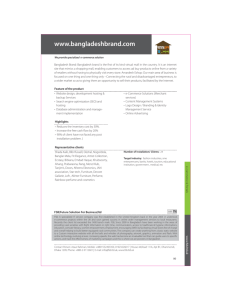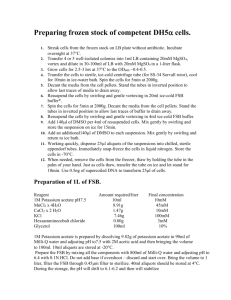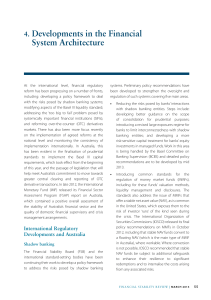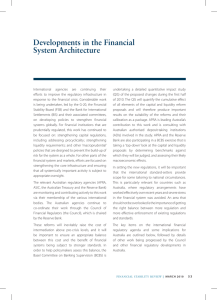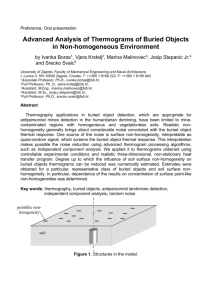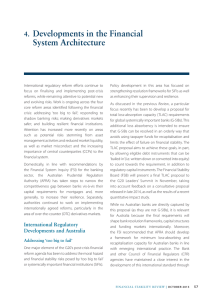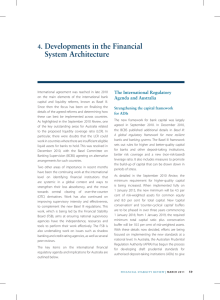Developments in the Financial System Architecture 4.
advertisement
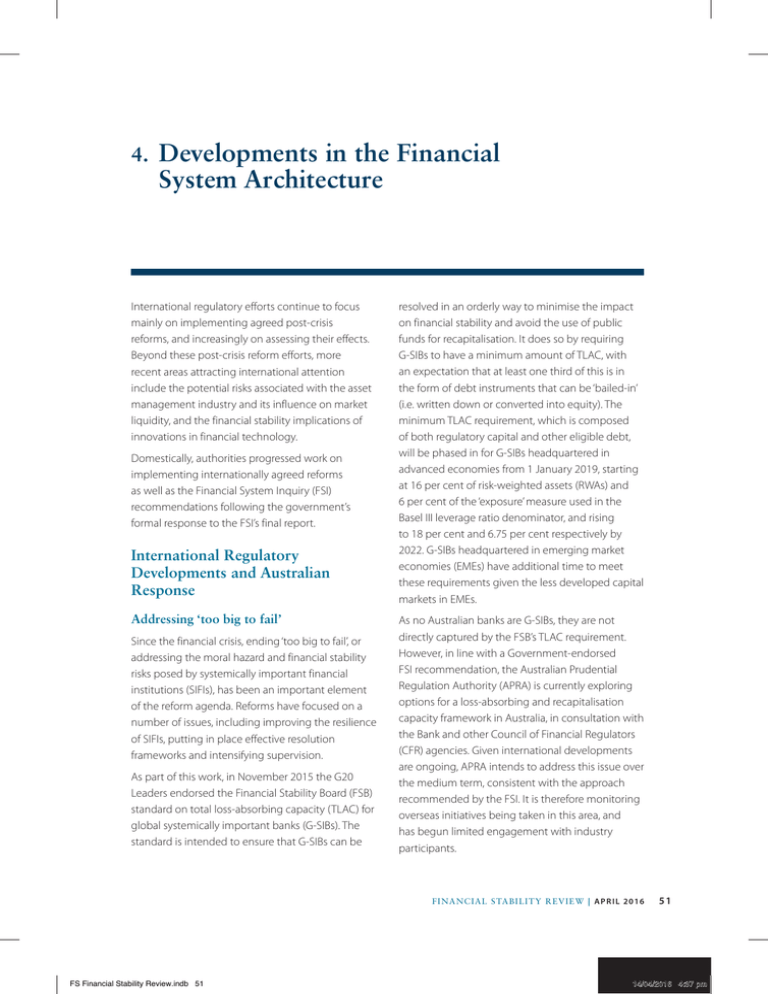
4.Developments in the Financial System Architecture International regulatory efforts continue to focus mainly on implementing agreed post-crisis reforms, and increasingly on assessing their effects. Beyond these post-crisis reform efforts, more recent areas attracting international attention include the potential risks associated with the asset management industry and its influence on market liquidity, and the financial stability implications of innovations in financial technology. Domestically, authorities progressed work on implementing internationally agreed reforms as well as the Financial System Inquiry (FSI) recommendations following the government’s formal response to the FSI’s final report. International Regulatory Developments and Australian Response Addressing ‘too big to fail’ Since the financial crisis, ending ‘too big to fail’, or addressing the moral hazard and financial stability risks posed by systemically important financial institutions (SIFIs), has been an important element of the reform agenda. Reforms have focused on a number of issues, including improving the resilience of SIFIs, putting in place effective resolution frameworks and intensifying supervision. As part of this work, in November 2015 the G20 Leaders endorsed the Financial Stability Board (FSB) standard on total loss-absorbing capacity (TLAC) for global systemically important banks (G-SIBs). The standard is intended to ensure that G-SIBs can be resolved in an orderly way to minimise the impact on financial stability and avoid the use of public funds for recapitalisation. It does so by requiring G-SIBs to have a minimum amount of TLAC, with an expectation that at least one third of this is in the form of debt instruments that can be ‘bailed-in’ (i.e. written down or converted into equity). The minimum TLAC requirement, which is composed of both regulatory capital and other eligible debt, will be phased in for G-SIBs headquartered in advanced economies from 1 January 2019, starting at 16 per cent of risk-weighted assets (RWAs) and 6 per cent of the ‘exposure’ measure used in the Basel III leverage ratio denominator, and rising to 18 per cent and 6.75 per cent respectively by 2022. G-SIBs headquartered in emerging market economies (EMEs) have additional time to meet these requirements given the less developed capital markets in EMEs. As no Australian banks are G-SIBs, they are not directly captured by the FSB’s TLAC requirement. However, in line with a Government-endorsed FSI recommendation, the Australian Prudential Regulation Authority (APRA) is currently exploring options for a loss-absorbing and recapitalisation capacity framework in Australia, in consultation with the Bank and other Council of Financial Regulators (CFR) agencies. Given international developments are ongoing, APRA intends to address this issue over the medium term, consistent with the approach recommended by the FSI. It is therefore monitoring overseas initiatives being taken in this area, and has begun limited engagement with industry participants. F IN AN C IAL STAB IL ITY R E VIE W | A P R I L 2 0 1 6 FS Financial Stability Review.indb 51 51 14/04/2016 4:37 pm The FSB has continued to work on enhancing jurisdictions’ resolution frameworks and monitoring implementation of reforms to resolution regimes: •• 52 In November, the FSB released a consultation paper on principles to ensure that G-SIBs have access to sufficient liquidity in resolution to maintain critical functions. The principles seek to encourage reliance on private sources of funding in resolution, for instance through a pool of industry funds, and to minimise moral hazard risks if public sector funding is temporarily required. •• Also in November, the FSB initiated a consultation on guidance to help authorities assess whether financial institutions’ resolution plans ensure the continuation of critical operations that are systemically important to broader financial markets. For example, the guidance highlights that contracts with critical service providers should not be disrupted by resolution and that adequate liquidity should be in place to support the services that enable critical operations to continue. •• In March 2016, the FSB released the results of a second peer review on the implementation of its Key Attributes of Effective Resolution Regimes for Financial Institutions (Key Attributes). The review, which focused on bank resolution powers and recovery and resolution planning requirements, found that only a few jurisdictions (mainly in the European Union) have a full set of powers in line with the Key Attributes, and that progress implementing resolution planning and resolvability assessments has been limited. It recommended that jurisdictions: extend the scope of regimes to entities such as foreign bank branches and bank holding companies; introduce recovery and resolution planning for all systemic banks; and put in place key resolution measures such as powers to ensure continuity of services as well as to bail in liabilities in resolution. Though some room for improvement was identified, Australia’s resolution framework for authorised deposit-taking institutions (ADIs) is generally aligned with the Key Attributes as well as with international peer jurisdictions. Consistency with the Key Attributes will be further enhanced by planned legislative changes to strengthen APRA’s crisis management powers (discussed below). Seeking to ensure that large banks with cross-border operations can be resolved in an orderly manner has also been a focus of G20 and FSB efforts in recent years. In line with this goal, in November 2015, the FSB published a set of principles that jurisdictions should consider including in their legal frameworks to give cross-border effect to resolution actions. The aim of this work is to allow resolution measures taken by one jurisdiction to be promptly recognised by other jurisdictions, so that authorities do not face obstacles in implementing orderly group-wide resolution plans. While the framework encourages statutory measures (i.e. changes to legal frameworks) to ensure cross-border enforceability of resolution actions, it acknowledges that, until their adoption, contractual mechanisms can also play an important role. A key recent example of such a contractual mechanism is the International Swaps and Derivatives Association Resolution Stay Protocol, which aims to prevent cross-border over-the-counter (OTC) derivative contracts from being terminated disruptively in the event of a foreign counterparty entering resolution. The Protocol was extended in November 2015 to cover securities financing transactions (SFTs). Parties adhering to the Protocol agree to ‘opt in’ to laws that govern temporary stays in jurisdictions that are identified under the Protocol. In Australia, a similar temporary stay power is included in legislation on OTC derivatives margining reforms (discussed below) which was introduced into Parliament in March. Once this is passed, it would be possible to seek to have Australia’s regime recognised under the Protocol. R ES ERV E B A N K O F AUS T RA L I A FS Financial Stability Review.indb 52 14/04/2016 4:37 pm While much of the post-crisis regulatory focus on SIFIs has been on enhancing bank resilience and resolution, work also continues to address risks posed by systemically important non-bank entities. prepare legislative reforms that will include updated proposals to strengthen APRA’s crisis management powers, as well as introduce a resolution regime for FMIs that aligns with the Key Attributes. •• •• The update to APRA’s crisis management powers builds on proposals consulted on in 2012 and covers all APRA-regulated entities. It will broaden APRA’s powers to respond to the distress or failure of a financial group or foreign bank branch, give binding directions and appoint a statutory or judicial manager. •• The resolution regime for FMIs will reflect the CFR’s November 2015 response to generally supportive feedback from a consultation last year. The planned regime would extend to all domestically incorporated and licensed clearing and settlement facilities, as well as trade repositories that are incorporated and licensed in Australia. It will also empower the Australian authorities to act to support overseas authorities resolving FMIs that are licensed to operate in Australia. In addition, the CFR sees a case for considering whether the scope of powers should be extended to address the situation in which offshore resolution authorities acted, or failed to act, in a way that adversely affected Australian interests. Under the planned regime the Bank would be the resolution authority for clearing and settlement facilities, with an overarching objective to maintain overall stability in the financial system and an additional key objective to maintain the continuity of critical FMI services. The Australian Securities and Investments Commission (ASIC) would be the resolution authority for trade repositories. •• In November 2015, the FSB released a consultation paper which provides guidance on how the Key Attributes should be applied to insurers. Relatedly, also in November, the International Association of Insurance Supervisors launched consultations on: (a) revisions to its assessment methodology for global systemically important insurers (G-SIIs); and (b) the concept of non-traditional non-insurance activities and products, which plays a role in the determination of the higher loss absorbency requirement for G-SIIs. As part of a broader international work plan to promote central counterparty (CCP) resilience, recovery and resolvability, the FSB is conducting further work on resolution issues specific to CCPs, to complement existing guidance. The FSB’s Resolution Steering Group, of which the Bank is a member, recently established a cross-border crisis management group for financial market infrastructures (FMIs). This group will consider, among other issues, whether a resolution authority needs access to additional loss allocation tools beyond those included in the CCP’s own recovery plan. Standards or guidance on CCP resolution issues are expected to be published for consultation by end 2016. In related work, the Committee on Payments and Market Infrastructures (CPMI) and the International Organization of Securities Commissions (IOSCO) have completed a stocktake of CCPs’ risk management practices and are currently developing additional guidance on the governance of risk management, stress testing and margin methodologies. Consultation on the additional guidance is expected to commence before the G20 Summit in September. Domestically, CFR agencies continue to work on strengthening Australia’s resolution and crisis management arrangements. Work is underway to Shadow banking As discussed in previous Reviews, the FSB and IOSCO have worked since the crisis to improve the oversight of shadow banking, meaning entities and activities involved in credit intermediation that are outside the regular banking system. In 2016, the focus is primarily on continued implementation of post-crisis reforms and implementation monitoring. F IN AN C IAL STAB IL ITY R E VIE W | A P R I L 2 0 1 6 04 Developments in Financial System.indd 53 53 14/04/2016 4:51 pm •• •• The FSB is in the process of reviewing implementation of its 2013 framework for monitoring and assessing risks from shadow banks other than money market funds (MMFs). The framework calls for regulators to assess the risks stemming from their shadow banking sectors (such as those arising from maturity/ liquidity transformation and leverage), adopt suggested policy tools where necessary, and share relevant information with other jurisdictions and the FSB. The Bank coordinated Australia’s input to the review, which is expected to be released in May. IOSCO is to undertake second-round peer reviews on the implementation of its 2012 recommendations for MMFs and securitisation. Domestically, in November APRA released amendments to its proposed prudential standard for securitisation. The proposal, which will work to further align Australia’s regulations with IOSCO’s recommendations, simplifies the regulatory structure for securitisation and seeks to make it straightforward for ADIs to use securitisation in a low-risk manner as a funding tool and for capital relief. Subject to consultation, APRA intends to implement the revised framework from 2018. In addition to implementation monitoring, international policy development work was ongoing in recent months, with the FSB finalising in November its framework for the application of haircut floors to non-bank-to-non-bank SFTs, such as repurchase agreements (or ‘repos’). Relatedly, the Basel Committee on Banking Supervision (BCBS) issued in November a draft proposal for incorporating haircut floors on non-centrally cleared bank SFTs into the Basel III capital framework. These haircut floors for both bank and non-bank entities form part of a broader set of recommendations released by the FSB in 2013 that seeks to address risks, such as procyclicality, that can stem from SFTs. Improved data on SFTs is a central element of these recommendations and, in November, the FSB also finalised its data collection standard, which requires 54 jurisdictions to collect data from institutions covering items such as outstanding loan and collateral values by maturity, currency, counterparty type and jurisdiction, repo rate and haircut. Domestically, a CFR working group has been assessing Australia’s current regulation of SFTs against the FSB’s recommendations. Meeting one of the FSB’s SFT recommendations, in October the Bank published its evaluation of the costs and benefits of central clearing of repos in Australia. The Bank concluded that it does not believe there is a financial stability case to actively promote the introduction of a repo CCP in the Australian market. However, should the industry proceed with a proposal for introducing such a CCP, the Bank would stand ready to engage in the debate and be willing to consider participation, subject to certain preconditions on continuity, location, design and terms of access. Building resilient financial institutions The BCBS continues to focus on monitoring the implementation of agreed international reforms aimed at enhancing the resilience of banking institutions, namely Basel III. In its report to the G20 Leaders in November, the BCBS indicated that implementation of the Basel III risk-based capital and liquidity reforms has generally been timely and consistent, and progress continues to be made in implementing the leverage ratio, Net Stable Funding Ratio (NSFR) and systemically important bank frameworks. Domestically, APRA continues to implement Basel III reforms, releasing a consultation paper in March outlining its proposals for the NSFR, which would come into effect from 1 January 2018, in line with the internationally agreed timetable. In its March semi-annual monitoring report, the BCBS found that all large internationally active banks met the fully phased in Basel III common equity requirements as at end June 2015. For the Basel III liquidity standards, the BCBS found that all banks covered by the monitoring report met the current minimum 60 per cent Liquidity Coverage R ES ERV E B A N K O F AUS T RA L I A 04 Developments in Financial System.indd 54 14/04/2016 4:51 pm adopting floors on model parameters; and limiting the range of parameter estimation practices. The consultation document states that the BCBS does not aim to significantly increase capital requirements and will consider the interactions between input floors, output floors and the leverage ratio when finalising the outstanding post-crisis reforms. Ratio requirement and around 80 per cent of all banks met the 100 per cent NSFR requirement. The BCBS also continues to work on finalising outstanding elements of the post-crisis policy development work, including capital floors, the revised standardised approaches, and a review of the role of internal models in the capital framework. The BCBS informed the G20 Leaders in November that it intends to finalise this work by end 2016. In recent months, the BCBS has published several documents that contribute to the completion of the post-crisis agenda: •• The BCBS’ work on the variability in RWAs has been informed by quantitative assessments of the variation in banks’ RWA calculations. In its second report on this, released in April, the BCBS found that RWA variability in banks’ retail and small business portfolios was partly driven by differences in the interpretation and application of the BCBS’ standards. For example, the use of short time series coupled with limited guidance on the definition of a ‘downturn’ can lead banks to apply different definitions when estimating the likely loss on a portfolio in the event of default, which could result in varied RWAs. The report also suggests that the improvement and harmonisation of model validation could help to reduce variability in bank RWAs. Consistent with the BCBS’ review of the capital framework and its aim to reduce excessive variability in RWAs, the BCBS published consultation documents on the revised standardised approaches for credit risk in December 2015 and operational risk in March 2016, and changes to the internal ratings-based (IRB) approaches to measure credit risk in March 2016: –– In response to an earlier consultation the BCBS has decided to reintroduce a role for external credit ratings for exposures to banks and corporates in the revised standardised approach for credit risk. –– In addition to updating the proposed standardised approach for operational risk, which will replace the three existing standardised approaches, the BCBS has proposed removing internal modelling for operational risk from the framework, since it considers that the current internal model-based approach is unduly complex and has exacerbated variability in banks’ RWAs. –– The BCBS has proposed three main changes to the IRB approaches: removing the option to use the IRB approaches for some portfolios, such as banks and large corporates, where model parameters cannot be sufficiently reliably estimated; •• In January, the BCBS finalised the revised market risk framework, which aims to address several structural flaws in the framework that were highlighted during the financial crisis. The revisions include updated standardised and internal modelling approaches, as well as a revised regulatory boundary between the banking book and the trading book to reduce the possibility of arbitrage across the two books. •• In March, the BCBS proposed revisions to the Pillar 3 framework, including the disclosure of a dashboard of key regulatory metrics and hypothetical RWAs calculated using the standardised approaches for credit risk, counterparty credit risk, market risk and the securitisation framework. These proposals form the second broad phase of the BCBS’ review of the Pillar 3 framework, which aims to improve F IN AN C IAL STAB IL ITY R E VIE W | A P R I L 2 0 1 6 04 Developments in Financial System.indd 55 55 14/04/2016 4:51 pm the comparability and consistency of bank disclosure requirements, particularly those relating to RWAs. •• The BCBS issued in April proposed revisions to the Basel III leverage ratio framework, which includes amendments to ensure that differences in accounting frameworks do not affect the leverage ratio calculations, as well as proposing additional leverage ratio requirements for G-SIBs. The consultation document also notes that the Basel III leverage ratio is to be based on a Tier 1 definition of capital and should comprise a minimum level of 3 per cent when the leverage ratio is implemented in 2018. Alongside the work to finalise outstanding reforms and monitor the implementation of reforms, as jurisdictions transition towards full implementation, there is increasing focus internationally on assessing the impact of reforms. In November, the FSB presented its first annual report on the implementation and impact of post-crisis reforms to the G20 Leaders’ Summit. The report found that the main reforms implemented to date, which mostly comprise the Basel III reforms, have led to a more resilient banking sector and do not appear to have resulted in a sharp reduction in bank lending. While it is too early to assess the impact of many reforms, the report highlights areas that merit ongoing monitoring, including bond market liquidity. Liquidity has been affected by regulations designed to shift risks from banks to end investors as well as changes in financial institutions’ own risk preferences, though both are expected to add to overall financial system resilience over the longer run. In its second annual report later this year, the FSB will include a review of any significant change in market liquidity and, if so, the causes and likely persistence of this. FMI regulation Internationally, CPMI and IOSCO continue to monitor the implementation of the Principles for Financial Market Infrastructures (PFMI), which are 56 the international standards for FMIs such as CCPs, securities settlement systems and systemically important payments systems. As part of this, a detailed assessment of the consistency of Australia’s framework with the PFMI was published in December. The report confirmed that Australia’s implementation was complete and consistent in most respects. Also, a peer review was published in November assessing the extent to which authorities in member jurisdictions are observing the parts of the PFMI that relate to their roles as regulators and supervisors of FMIs. This found that the Bank and ASIC observed all the responsibilities for authorities, as set out in the PFMI, in their regulation of all types of FMIs. CPMI and IOSCO are also assessing whether FMIs are achieving consistent outcomes in their implementation of the PFMI, beginning with an assessment of derivatives CCPs’ financial risk management. This is expected to be published mid year. The scope of this review includes ASX Clear (Futures) and both of the overseas CCPs licensed to clear OTC derivatives in Australia. Risks and reforms beyond the post-crisis agenda Work is continuing in two areas of potential risks discussed in the previous Review: •• The FSB has progressed work assessing the possible financial stability risks posed by asset management activities. Last year, the FSB highlighted the elevated near-term risks due in part to the unwinding of extraordinary policies and the potential reduction in market liquidity. As a result, the FSB encouraged asset managers to use stress testing to assess their ability individually and collectively to meet redemptions under difficult market liquidity conditions. In March, the FSB Plenary considered work assessing longer-term structural asset management vulnerabilities, including those associated with fund liquidity mismatch and leverage. The FSB expects to issue policy R ES ERV E B A N K O F AUS T RA L I A 04 Developments in Financial System.indd 56 14/04/2016 4:51 pm –– In March, a consultation was initiated on regulatory reforms to significant financial benchmarks in Australia. The reform proposals relate to the administration of significant benchmarks, submission to significant benchmarks, and offences applying to benchmark misconduct. The proposals are guided by the IOSCO Principles for Financial Benchmarks and the recommendations of the FSB, as well as reforms in other jurisdictions. recommendations for consultation mid year with the intention of finalising them by end 2016. •• In November, the FSB released progress reports on its efforts to address vulnerabilities from market misconduct and assess the decline in correspondent banking. Since the misconduct risk work plan was finalised in April 2015, several standard-setting bodies have advanced work across the four identified areas: the role of incentives, such as compensation and governance frameworks, in reducing misconduct; reforms to financial benchmarks and improving standards of conduct in fixed income, currency and commodities markets; coordination in the application of conduct regulations; and the potential withdrawal from correspondent banking. The bulk of work across these areas is expected to be completed by end 2016, although the full text of the global foreign exchange code of conduct is not scheduled to be released until May 2017. More recently, standard-setting and other international bodies have begun work in several new areas: •• Reflecting a priority under China’s G20 presidency, the International Monetary Fund, the FSB and the Bank for International Settlements will conduct a stocktake of international experiences and potential lessons with macroprudential policy frameworks and tools. This work aims to inform authorities of the key aspects of macroprudential policymaking, including processes to analyse systemic risks and the tools available to address vulnerabilities. Progress on this work will be discussed by G20 Ministers and Governors in July and a review of international experiences and lessons will be delivered to the G20 Summit. In contributing to this work, the Bank and other CFR agencies will be emphasising points they have made in recent years, including that macroprudential policy can be regarded as a subset of effective financial stability policy so that explicit separate governance arrangements for macroprudential policy may not be necessary.1 •• As part of its broader work on assessing vulnerabilities and sources of systemic risks, The CFR has also been active in seeking to improve the integrity and reliability of financial benchmarks: –– Between October and February, the CFR conducted a consultation on the methodology underpinning the bank bill swap rate (BBSW) in response to concerns arising from the low trading activity during the BBSW rate set. Most of the submissions acknowledged that changes to the BBSW methodology were likely to be necessary. Following this feedback, in February the CFR released a discussion paper recommending that the definition of the market underlying the BBSW be broadened and that the benchmark be calculated directly from transactions. The CFR has asked the administrator of the BBSW, the Australian Financial Markets Association, to work on amendments to the BBSW methodology for implementation later in the year. 1 For further CFR agency perspectives on macroprudential policy, see RBA-APRA (2012), Macroprudential Analysis and Policy in the Australian Financial Stability Framework, September; Edey M (2012), ‘Macroprudential Supervision and the Role of Central Banks’, Remarks to the Regional Policy Forum on Financial Stability and Macroprudential Supervision, 28 September; Ellis L (2012), ‘Macroprudential Policy: A Suite of Tools or a State of Mind?’ Paul Woolley Centre for the Study of Capital Market Dysfunctionality Annual Conference, 11 October. F IN AN C IAL STAB IL ITY R E VIE W | A P R I L 2 0 1 6 FS Financial Stability Review.indb 57 57 14/04/2016 4:37 pm physical risk to property from increasingly severe weather events; liability risk to insurers if legal claims are made against carbon emitters; and transition risk if a policy change or climate event were to result in a sharp repricing of carbon-related assets. In response to these risks, the FSB has established an industry-led taskforce to consider how corporate disclosures could be improved to help regulators, investors and firms better take into account risks from climate change. The taskforce released a consultation paper on 1 April outlining its scope, objectives and work program for the period ahead. It intends to provide a final set of recommended principles for effective disclosures by end 2016. the FSB is exploring the potential financial stability risks from operational failures at financial institutions. CPMI-IOSCO have also continued work on operational risks, publishing in November draft guidance for consultation on cyber resilience for FMIs. Separately, IOSCO also published in April a review of different regulatory approaches and tools for dealing with cyber risk. Alongside international efforts, national regulators in a number of jurisdictions, including in Australia, have increased their focus on these issues in recent years. In March, ASIC released an assessment of the cyber resilience of Australia’s major domestic FMIs (ASX Group and Chi-X Australia Pty Ltd), which found that to date the FMIs have managed cyber resilience in a manner consistent with their statutory obligations. •• The FSB is assessing the systemic implications of financial technology (‘fintech’) innovations such as blockchain and distributed ledger technology. The FSB is seeking to ensure that the regulatory framework is able to manage any systemic risks that arise from technological change without stifling innovation. In November, the CPMI published a report on digital currencies and distributed ledger technology, noting that the latter, in particular, might affect payment services and FMIs more broadly. Domestically, the government released a statement in March on its ‘fintech’ policy, and a CFR working group, that also includes the Australian Transactions Reports and Analysis Centre (AUSTRAC) was recently established to coordinate research into blockchain innovations, including potential implications for the financial system. The private sector is also investigating this technology and its potential uses in Australia: for example, the ASX is exploring distributed ledger technology for a planned replacement of its equities clearing and settlement system. •• 58 The FSB has been exploring possible risks to financial stability from climate change. This work has identified three risks to financial stability: Other Domestic Developments Government response to the Financial System Inquiry In October, the government released its response to the FSI’s final report. Overall, the government expressed its support for almost all of the FSI’s 44 recommendations and agreed with the FSI that Australia’s regulatory architecture did not require major changes. Recommendations that the government supported pertaining to the Bank’s financial stability and payments system responsibilities included the following: •• Increasing the resilience of the banking sector, including through APRA’s recent actions to strengthen banks’ capital positions, the crisis management reform package noted above, and the implementation of the Basel III leverage ratio. •• Maintaining the ex-post funding structure of the Financial Claims Scheme for ADIs. •• Strengthening regulator accountability by: –– reconstituting the Financial Sector Advisory Council with revised terms of reference to include providing advice on the performance of the financial regulators (including the payments regulation function of the Bank); and R ES ERV E B A N K O F AUS T RA L I A FS Financial Stability Review.indb 58 14/04/2016 4:37 pm –– updating regulators’ Statements of Expectations in the first half of 2016 and providing a Statement of Expectations to the Bank’s Payments System Board (PSB) for the first time. •• Enhancing payments system regulation by: –– charging the Australian Competition and Consumer Commission (ACCC) with the enforcement of surcharge regulations determined by the PSB. In February, the Parliament passed legislation implementing this change; the legislation provides the ACCC with the power to take action against merchants surcharging in excess of permitted surcharge levels to be defined in standards determined by the Bank. The PSB expects to determine final standards at its May meeting. –– clarifying ASIC’s and the Bank’s powers to regulate new payments systems, such as digital currencies; and –– requesting APRA, ASIC and the Bank work to ensure that there is a graduated framework for payments regulation. The Government also supported the PSB progressing its Review of Card Payments Regulation. As discussed in previous Reviews, the PSB has been undertaking a review of the framework for the regulation of card payments. In December, the Bank published a consultation paper setting out a range of options for possible reform, including draft standards on interchange and surcharging. The Bank received over 40 substantive responses to the consultation paper, and has been meeting with relevant stakeholders to discuss their submissions. OTC derivatives markets reform In recent months Australian authorities have continued to make progress in implementing internationally agreed OTC derivatives market reforms – in particular, those relating to mandatory central clearing. Requiring that standardised OTC derivatives transactions be cleared through a CCP can simplify the network of interconnections between financial institutions, reduce total counterparty credit exposures, and standardise counterparty risk management. In Australia, ASIC recently finalised rules imposing mandatory clearing obligations for internationally active dealers in Australian dollar-, US dollar-, euro-, British pound- and Japanese yen-denominated interest rate derivatives. These rules came into effect from 4 April 2016. In their November Report on the Australian OTC Derivatives Market, APRA, ASIC and the Bank concluded that they did not see a case for extending the product scope of the Australian central clearing mandate at this time. The main areas where domestic implementation of global OTC derivatives-related reforms is ongoing are margining and risk management requirements for non-centrally cleared derivatives. Margin is collateral designed to reduce the potential for contagion from the default of a market participant. APRA is currently consulting on draft Prudential Standards which would impose these requirements in Australia. Legislation was introduced to Parliament in March that would enable Australian entities to exchange margin in line with BCBS-IOSCO standards. Clearing and settlement facilities In recent months, regulatory bodies in Australia have clarified their views on two key elements of the framework for clearing and settlement facilities: •• Operating in Australia. In November, the CFR released its response to a consultation on a proposed new approach to assessing whether an ‘overseas’ clearing and settlement facility should be subject to regulation in Australia. Under the proposals, a two-stage test would be applied to make this determination. In the first stage it would be determined whether the facility had any connection at all to the Australian financial system. Where this condition was met, the second stage would assess the F IN AN C IAL STAB IL ITY R E VIE W | A P R I L 2 0 1 6 FS Financial Stability Review.indb 59 59 14/04/2016 4:37 pm materiality of that connection from a public policy perspective. ASIC, the Bank and the Treasury are currently developing formal proposals to implement the new approach. •• 60 Competition in cash equities. In March, the government endorsed the CFR’s recommendations from a review of competition in the clearing of Australian cash equities. This work was undertaken in collaboration with the ACCC. In its conclusions, the CFR recommended that the government make a number of legislative changes. The proposed changes would support competition in the clearing of cash equities, while also ensuring the safety of the market. They would also underpin a set of regulatory expectations for the ASX’s conduct in operating its cash equity clearing and settlement facilities until such time as a competitor emerged. Prudential regulation In March, APRA released for consultation its updated framework for the supervision of conglomerate (Level 3) groups. Level 3 groups are made up of APRA-regulated institutions that have material operations across more than one APRA-regulated industry and/or in one or more non-APRA-regulated sector (such as a bank operating in insurance and/or funds management). The framework seeks to ensure that APRA can adequately supervise the risks to which APRA-regulated entities within Level 3 groups are exposed and covers four key areas: group governance, risk exposures, risk management and capital adequacy. R R ES ERV E B A N K O F AUS T RA L I A FS Financial Stability Review.indb 60 14/04/2016 4:37 pm

